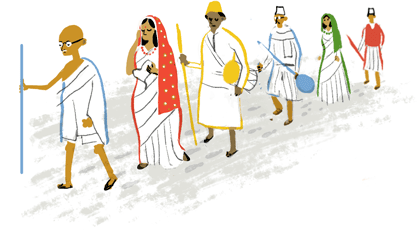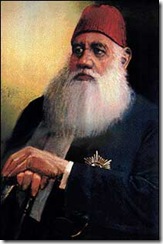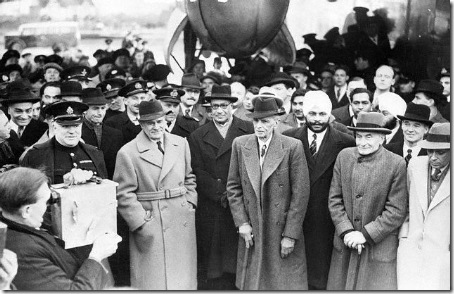Five places in Mumbai that were part of India's freedom struggle
Saturday, 15 August 2015 - 8:46am IST | Agency: dna | From the print edition
dna profiles five of the most prominent places of Mumbai which have been part of India's freedom struggle.
Salman Ansari dna
The growth of political consciousness in Mumbai started after the establishment of the Bombay Presidency Association byDadabhoy Nauroji on January 31, 1885. Then, the partition of Bengal in 1905, which initiated the Swadeshi movement, had a tremendous impact on Bombay. This intensified on July 22, 1908, when Lokmanya Tilak, who was spearheading the Swadeshi movement in Bombay, was sentenced to six years' imprisonment; there were huge protests across the city.
Five years later, in April 1913, Congress leader Pherozeshah Mehta started The Bombay Chronicle, a newspaper which played an important role in the national movement till India's Independence.
However, the most important event in Bombay early in 1915 was Mahatma Gandhi's visit, which led to mass movement in support of the freedom struggle.
dna profiles five of the most prominent places of Mumbai which have been part of India's freedom struggle.
Bombay Harbour: Where the most spectacular revolt against the British rule took place
The Royal Indian Navy Mutiny of February 18, 1946, at Bombay Harbour marked the first and most serious revolt by Indian sailors against the British rule. Shipmen posted at HMS Talwar announced a strike to oppose the Raj. The next day, they took over the naval trucks and started patrolling the city, inviting the masses to join in the struggle. Union Jacks were torn down and the rebels hoisted red flags. Within 48 hours the revolt spread to 74 ships, 20 fleets and 22 units of the navy along the coast of Calcutta, Karachi, Madras, Cochin and Vishakhapatam.
Despite widespread effect, the revolt failed to get the political backing. On February 22-23, over 250 sailors were killed by the imperialist forces. Strikers were forced to surrender. Most of them were executed later. However, after the navy uprising, the British prime minister announced that the British would leave India before June 1948.
The Royal Indian Navy Mutiny of February 18, 1946, at Bombay Harbour marked the first and most serious revolt by Indian sailors against the British rule. Shipmen posted at HMS Talwar announced a strike to oppose the Raj. The next day, they took over the naval trucks and started patrolling the city, inviting the masses to join in the struggle. Union Jacks were torn down and the rebels hoisted red flags. Within 48 hours the revolt spread to 74 ships, 20 fleets and 22 units of the navy along the coast of Calcutta, Karachi, Madras, Cochin and Vishakhapatam.
Despite widespread effect, the revolt failed to get the political backing. On February 22-23, over 250 sailors were killed by the imperialist forces. Strikers were forced to surrender. Most of them were executed later. However, after the navy uprising, the British prime minister announced that the British would leave India before June 1948.
Gowalia Tank Maidan: The place of the Quit India resolution where the Tricolour was first hoisted
On July 14, 1942, the Indian National Congress passed a resolution demanding complete freedom to the nation from the British. On the intervening night of August 8-9, 1942, the Congress passed the famous 'Quit India resolution', which electrified the country. This has become the popular 'Quit India Movement', and the mass civil disobedience movement was launched with Mahatma Gandhi's "do or die" call.
The British police treated the masses brutally. At that time, Aruna Asaf Ali hoisted the Tricolour on the Gowalia Tank Maidan proudly, which was a first.
Within a few hours of the resolution and call, all national leaders were arrested. As there were no leaders outside, the movement became violent. The British government moved the army and more than 1 lakh people were arrested. All leaders and freedom fighters who participated in the movement were released only after three years, after World War II ended.
On July 14, 1942, the Indian National Congress passed a resolution demanding complete freedom to the nation from the British. On the intervening night of August 8-9, 1942, the Congress passed the famous 'Quit India resolution', which electrified the country. This has become the popular 'Quit India Movement', and the mass civil disobedience movement was launched with Mahatma Gandhi's "do or die" call.
The British police treated the masses brutally. At that time, Aruna Asaf Ali hoisted the Tricolour on the Gowalia Tank Maidan proudly, which was a first.
Within a few hours of the resolution and call, all national leaders were arrested. As there were no leaders outside, the movement became violent. The British government moved the army and more than 1 lakh people were arrested. All leaders and freedom fighters who participated in the movement were released only after three years, after World War II ended.
Gokuldas Tejpal Sanskrit Pathshala: The place where foundation of the Congress took place
The foundation of the Indian National Congress in 1885 was one of the most important political events in Bombay. On December 28, 1885, delegates gathered at Gokuldas Tejpal Sanskrit Pathshala, near Gowalia tank, to form the INC, with WC Bannerjee in the chair and AO Hume assuming office as the general secretary. Other important delegates included Dadabhai Naoroji, Justice Ranade, Pherozeshah Mehta and Dinshaw Wacha.
The first session of the Indian National Congress was held from December 28 to 30 in the school. The Congress was created by British rulers to form a platform for civic and political dialogue of educated Indians, especially after the transfer of India from the East India Company to the British Empire.
The foundation of the Indian National Congress in 1885 was one of the most important political events in Bombay. On December 28, 1885, delegates gathered at Gokuldas Tejpal Sanskrit Pathshala, near Gowalia tank, to form the INC, with WC Bannerjee in the chair and AO Hume assuming office as the general secretary. Other important delegates included Dadabhai Naoroji, Justice Ranade, Pherozeshah Mehta and Dinshaw Wacha.
The first session of the Indian National Congress was held from December 28 to 30 in the school. The Congress was created by British rulers to form a platform for civic and political dialogue of educated Indians, especially after the transfer of India from the East India Company to the British Empire.
Mani Bhawan: The place where Mahatma Gandhi stayed and launched many movements
Located on Laburnum Road in Gamdevi, this serene two-story building was Mahatma Gandhi's home from 1917 to 1934. If these walls could speak, they would talk about the many important movements against the British rule that were launched from here — the Satyagraha movement, the Swadeshi movement, meetings to launch the Civil Disobedience Movement, as well as Gandhi's fasts for peace.
Today, it is an ode to Gandhi and to all things Gandhian. You can see photos of the freedom struggle and some of Gandhi's personal life; you can hear his speeches on earphones, and read his letters, you can also see his personal possessions. Mani Bhavan also houses a reading library.
Located on Laburnum Road in Gamdevi, this serene two-story building was Mahatma Gandhi's home from 1917 to 1934. If these walls could speak, they would talk about the many important movements against the British rule that were launched from here — the Satyagraha movement, the Swadeshi movement, meetings to launch the Civil Disobedience Movement, as well as Gandhi's fasts for peace.
Today, it is an ode to Gandhi and to all things Gandhian. You can see photos of the freedom struggle and some of Gandhi's personal life; you can hear his speeches on earphones, and read his letters, you can also see his personal possessions. Mani Bhavan also houses a reading library.
Gateway of India: From where the last British troops left India
The Gateway of India was erected to commemorate the landing of British King George V and Queen Mary at Apollo Bunder. The governor of Bombay, Sir George Sydenham Clarke, laid its foundation on March 31, 1911, after getting the final design from George Wittet. The construction was finished in 1924.
Ironically, this is the place through which the last British troops left India, marking the end of British rule on February 28, 1948. The last British serving battalion, the first Somerset Light Infantry, embarked from Bombay on the morning of February 28 on the 'Empress of Australia' on their voyage home after receiving guards of honour by crack contingents of the Indian Army.
The Gateway of India was erected to commemorate the landing of British King George V and Queen Mary at Apollo Bunder. The governor of Bombay, Sir George Sydenham Clarke, laid its foundation on March 31, 1911, after getting the final design from George Wittet. The construction was finished in 1924.
Ironically, this is the place through which the last British troops left India, marking the end of British rule on February 28, 1948. The last British serving battalion, the first Somerset Light Infantry, embarked from Bombay on the morning of February 28 on the 'Empress of Australia' on their voyage home after receiving guards of honour by crack contingents of the Indian Army.



Its Netaji Subhas not Gandhi Satyagraha brought freedom to India - Subramanian Swamy.